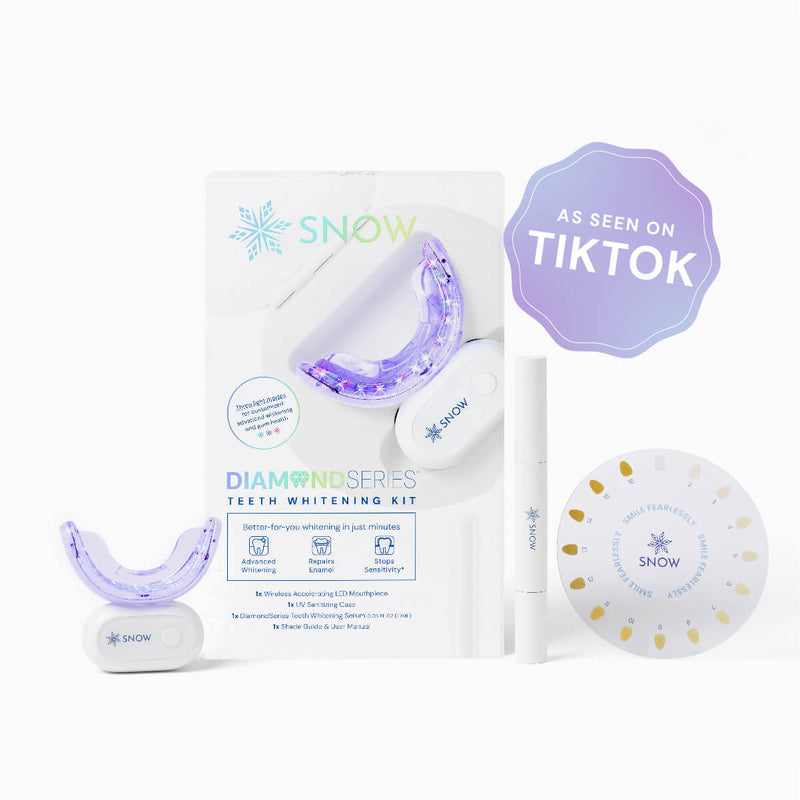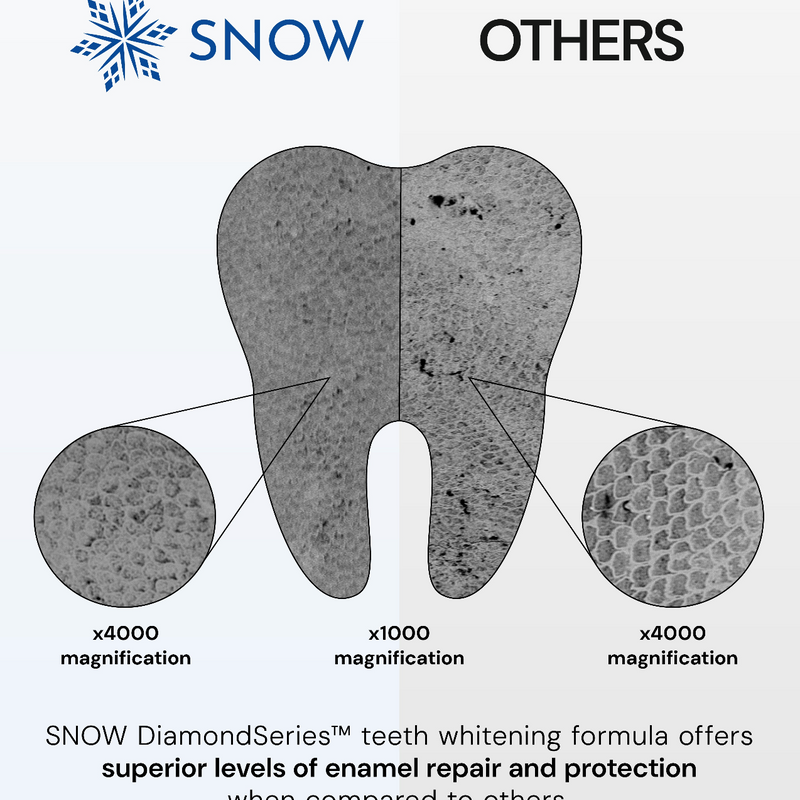"How to get rid of weed stains on teeth?" is a question many cannabis enthusiasts find themselves asking. Simply put, weed stains on teeth are discolorations caused by frequent cannabis consumption.
These stains, much like those from coffee or tobacco, can dull your once radiant smile. But there's hope!
In this article, we'll delve deep into understanding these stains, explore effective removal techniques, and offer preventive measures.
With expert insights from SNOW, you'll be equipped to restore and maintain that dazzling smile. Let's get started!
What this article covers:- What Can You Use To Get Rid of Weed Stains on Teeth?
- Understanding Weed Stains on Teeth
- How to Prevent Weed Teeth Stains
- What Habits Contribute to Stains?
What Can You Use to Get Rid of Weed Stains on Teeth?
When it comes to tackling weed stains on teeth, the market is flooded with options. However, not all solutions are created equal. At SNOW, we pride ourselves on offering top-tier, scientifically-backed products that deliver visible results. Here's a rundown of our most effective treatments for weed stains:
- SNOW® Teeth Whitening Kit: Our flagship product, this kit is a game-changer. It's designed to tackle tough stains, including those from cannabis, ensuring you get a brighter smile in no time. With over 5615 positive reviews, it's a favorite among our users.

- Magic Teeth Whitening Strips: A convenient option for those on-the-go, these strips are easy to use and show results in just a few applications.
- Advanced Vitamin Infused Whitening Toothpaste: Start and end your day right. This whitening toothpaste not only combats stains but also infuses your teeth with essential vitamins.
- Toothpaste Whitening Booster Gel: Boost your regular brushing routine with this gel. It's designed to amplify the effects of your regular toothpaste, targeting stubborn stains.
- Extra-Strength Sensitive Teeth Whitening Serum: For those with sensitive teeth, this serum is a godsend. It's formulated to provide maximum whitening without the usual sensitivity.
- Teeth Whitening Foam: A new addition to our lineup, this foam is perfect for daily use, ensuring your teeth stay stain-free.
Remember, while there are numerous treatments available, it's essential to choose products that are both effective and safe. At SNOW, we've spent years perfecting our formulas, ensuring they're suitable for all, including those with sensitive teeth. Our commitment to quality and our vast array of positive reviews stand testament to our expertise in the field.
Ready to bid farewell to weed stains? Dive into our collection and find the perfect solution tailored to your needs. Your radiant smile awaits!
Understanding Weed Stains on Teeth
Weed stains on teeth are extrinsic discolorations that form on the enamel due to the consumption of cannabis. But what exactly causes these stains, and how do they differ from other types of dental discolorations? Let's delve deeper.
What Are Extrinsic Stains?
Extrinsic stains are surface-level discolorations that occur on the outermost layer of the teeth, known as the enamel. These stains are typically caused by external factors such as foods, drinks, and lifestyle habits.
In the case of cannabis, the compounds present in the plant can lead to a yellow or brownish hue on the teeth over time.
Why Does Cannabis Cause Staining?
Cannabis, especially when smoked, releases tar and other compounds that can adhere to the enamel. Over time, with regular consumption, these compounds can lead to visible staining. It's similar to the way tobacco causes staining, though the intensity and color might vary.
How Do Weed Stains Compare To Other Stains?
While weed stains are primarily yellowish or brownish, other substances can cause different shades of discoloration. For instance, coffee and tea often lead to brown stains, while red wine can cause purple or grayish hues.
The good news is that, with treatments like our SNOW Teeth Whitening Kit, these stains can be effectively addressed.

The Role Of Oral Hygiene
Maintaining good oral hygiene is crucial. Regular brushing, especially after consuming stain-causing substances, can help reduce the intensity of these stains. Our range of whitening toothpastes and serums is designed to target and mitigate such extrinsic stains, ensuring your smile remains bright and radiant.
Understanding the nature and cause of weed stains is the first step toward addressing them. At SNOW, we're committed to providing solutions that are both effective and safe, ensuring you can enjoy your favorite habits without compromising on your smile.
How To Prevent Weed Teeth Stains
Preventing weed teeth stains is entirely possible with the right approach. While cannabis can lead to discoloration over time, certain measures can help you enjoy your favorite herb without compromising your radiant smile. Let's explore some effective preventive strategies.
Regular And Effective Oral Hygiene
The first line of defense against weed stains is maintaining impeccable oral hygiene. Brushing at least twice a day, especially after consuming cannabis, can significantly reduce the risk of staining.
Our SNOW Advanced Vitamin Infused Whitening Toothpaste is specially formulated to combat potential stains while nourishing your teeth.

Rinse After Consumption
Every time you consume cannabis, especially when smoked, make it a habit to rinse your mouth with water. This simple act can wash away many of the compounds that lead to staining before they have a chance to settle on your teeth.
Stay Hydrated
A dry mouth can exacerbate staining as it provides an ideal environment for stain-causing compounds to adhere to the teeth. Drinking water throughout the day, especially after cannabis consumption, not only keeps you hydrated but also helps wash away potential staining agents.
Limit Other Staining Substances
If you're a cannabis enthusiast, consider cutting back on other stain-causing foods and drinks like coffee, tea, and red wine. Reducing the overall stain-causing agents you consume can make a noticeable difference in the color of your teeth.
Use SNOW's Whitening Products Regularly
Prevention is not just about avoiding stains but also about regularly using products that can counteract potential discoloration. Our range of teeth whitening products, from serums to kits, are designed to combat and prevent stains, ensuring your smile remains as bright as ever.
A proactive approach can help you prevent weed stains. At SNOW, we're dedicated to ensuring that you can enjoy life's pleasures without sacrificing your beautiful smile.
What Habits Contribute To Stains?
Teeth discoloration can be influenced by a myriad of habits. While cannabis is one contributor, several other everyday practices can lead to stains on your pearly whites. At SNOW, we believe in empowering you with knowledge so you can make informed decisions about your oral health.
Let's explore the common habits that contribute to tooth staining.
Tobacco Use
One of the most significant contributors to tooth staining is tobacco. Whether you're smoking or chewing, tobacco contains tar and nicotine, which can lead to yellow or brown discolorations over time.
Consumption Of Dark Beverages
Your morning cup of coffee or evening glass of red wine might be affecting the color of your teeth. Dark beverages, including tea, cola, and certain fruit juices, contain chromogens that can adhere to the enamel, leading to stains.

Certain Foods With Strong Pigments
Foods with intense colors, such as berries, beets, and certain spices like turmeric, have the potential to stain teeth. While they're nutritious and delicious, it's a good idea to rinse your mouth after consuming them.
Aging
As we age, the enamel on our teeth gets thinner, revealing the yellowish dentin beneath. This natural process can give teeth a more discolored appearance over time.
Certain Medications
Some medications, including certain antihistamines, antipsychotics, and blood pressure medications, can lead to tooth discoloration. If you're on long-term medication, it's worth discussing potential side effects with your healthcare provider.
Inadequate Oral Hygiene
Neglecting regular brushing and flossing can allow plaque to build up, leading to both extrinsic and intrinsic stains. Using SNOW's range of oral care products can help combat this and maintain a radiant smile.
Conclusion
Understanding the root causes and adopting effective preventive and treatment measures can make all the difference. So, how to get rid of weed stains on teeth?
With the right knowledge, consistent oral hygiene, and the power of SNOW's innovative teeth whitening solutions, you can combat and prevent these stains, ensuring a radiant smile that lasts.
Ready to embark on a brighter, more confident smile journey? Discover SNOW's range of teeth whitening products today and let your smile shine its brightest!
If you found this article helpful, be sure to check out these related posts:
- How To Remove Tobacco Stains From Teeth Instantly
- Does Smoking Out Of A Bong Stain Your Teeth
- Does Smoking Cigarettes Make Your Teeth Yellow
- How Long After Teeth Whitening Can I Smoke
- Can You Vape With Teeth Whitening Trays In
- Does Nicotine Gum Make Your Teeth Yellow
- Do Nicotine Pouches Stain Your Teeth
- Do Cigars Make Your Teeth Yellow
- Can Your Teeth Turn Yellow From Vaping
- How To Keep Teeth White While Smoking
- White Spots on Teeth After Whitening
- How to Remove White Spots on Teeth at Home
- White Hard Stuff on Teeth
- White Spots on Teeth When Sick
- Do You Brush Your Teeth After Whitening Strips?
























